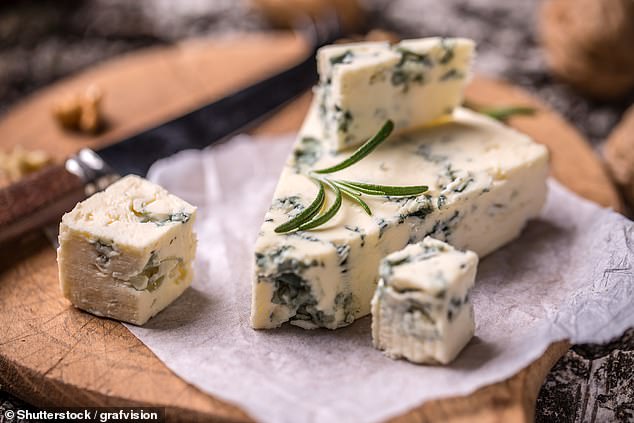REVEALED: The foods you can eat even if they’re MOLDY…and the ones that will send you to the ER, according to top food safety expert
When it comes to food safety, many subscribe to the old adage; if in doubt, throw it away.
But being careful often means saying goodbye to expensive groceries, possibly before it’s really necessary.
Some foods, such as hard cheeses, can be salvaged. But some types of contaminated dairy and multi-colored spots on soft products can send you to the hospital.
Dr. Keith Schneider, a food safety expert at the University of Florida, told DailyMail.com that while it pains him to tell people to throw away food at a time when grocery costs are higher than they have been in years, “I’m more concerned about telling of people to save food that is potentially harmful.’
Although you won’t see harmful bacteria like E. Coli growing on food, experts advise consumers to stay alert for color or texture changes that could indicate something has changed.
According to leading food experts, the general rule of thumb is to throw away your food if mold develops. But some foods, such as hard cheeses and chocolates, can be saved by cutting a 1-inch perimeter around the mold
Mold is a type of fluffy fungus that grows naturally on food and plays an important role in the breakdown of matter, or rotting. It reproduces by producing spores that can disperse in the air and thrives in warm, moist environments.
Dr. Schneider said: ‘Not all fungi are pathogenic. Occasionally some molds produce toxins, but unless you’re a mold expert it’s hard to tell which ones are disease-causing.”
Some molds are harmless and can be removed by cutting away the affected area on your food, but other types of mold produce mycotoxins, which at best can cause intestinal upset and vomiting and at worst can lead to organ damage and some types of mold. cancer.
Mycotoxins are produced by certain types of fungi, including Aspergillus species, Penicillium species, Fusarium verticillioides and Fusarium proliferatum.
Certain cheeses are especially suitable for growing mycotoxins. Soft and semi-soft cheeses have a relatively high moisture content, which creates an environment suitable for mold growth.
If you don’t store the cheese at low enough temperatures, you increase the risk that your favorite piece of cheese or rind will develop a downy bloom.
Dr. Schneider said, “If you have soft cheese like gorgonzola or mozzarella, just throw it away because nasty mold can release toxins that can spread through the liquid.”
With hard cheeses, such as hard cheddar, you can cut off a centimeter and thus avoid any toxins that may have formed.’
Hard cheeses have a shelf life of three to four weeks once opened if stored properly, while soft cheeses typically have a shelf life of about a week after opening the package. Yogurt, like soft cheeses, should also be discarded if mold develops.

Some types of cheese, such as Roquefort and blue cheese, are deliberately inoculated with specific mold spores during the cheese-making process and are harmless

Food safety experts told DailyMail.com that foods such as cooked rice, melon and hard-boiled eggs should be eaten a day or two after purchase as they can lead to food poisoning.
A concerning type of mold that grows on produce, Stachybotrys chartarum, commonly known as black mold or toxic black mold, produces mycotoxins in fruits and vegetables stored in moist or humid environments.
This appears as faint black spots and spots on fruits and vegetables, usually tomatoes.
Exposure to these mycotoxins can lead to several health problems, including respiratory problems, allergic reactions, skin irritation, and in severe cases, neurological symptoms or organ damage.
Soft loaves of bread should also not be salvaged. Think white sandwich bread, muffins and bagels.
The most common type of mold that grows on bread is called Rhizopus stolonifer, which appears as white or grayish fur-like spots on the surface of the bread and can spread quickly if left unchecked.
It can produce spores that can cause allergic reactions and breathing problems.
Dr. Schneider added, “We are exposed to small amounts of these fungi all the time, and all in all the body is quite good at repairing itself, but if you have a large mass of fungus, we can get a more than desirable amount.” dose.’
Firmer products with a skin, such as carrots and apples, can sometimes be stored in the same way as hard cheeses.
Chocolate, which can also form white blooms, can also sometimes be saved, depending on how widespread the moldy spots appear.
The white spots are harmless; they form when the chocolate comes into contact with moisture, which mars the appearance of the sugar crystals.
Keep in mind that your chocolate bar probably won’t taste as good or have the same creamy texture.
An approximate one 48 million Americans getting sick every year from spoiled food. About 128,000 people are hospitalized and 3,000 people die.
A common misconception about food safety is the importance of the expiration date. A wide range of foods, especially cartons of milk, have dates marked on them that many people subscribe to, throwing away products that were likely good for a few more days.
Milk should be discarded if it smells bad, but Dr. Schneider added that if properly refrigerated, you should have about seven days of wiggle room.
He said, “If milk is in a car where it’s 90 to 100 degrees, you might not get seven days. If you pack it in an insulated grocery bag, you can meet that date and then some. There are a lot of variables that keep you from picking a hard and fast number.”
